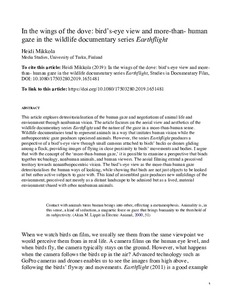In the wings of the dove: bird's-eye view and more-than-human gaze in the wildlife documentary series Earthflight
Mikkola Heidi
https://urn.fi/URN:NBN:fi-fe2021042822322
Tiivistelmä
This article explores deterritorialisation of the human gaze and negotiations of animal life and environment through nonhuman vision. The article focuses on the aerial view and aesthetics of the wildlife documentary series Earthflight and the nature of the gaze in a more-than-human sense. Wildlife documentaries tend to represent animals in a way that imitates human vision while the anthropocentric gaze produces speciesed animals. However, the series Earthflight produces a perspective of a bird's-eye view through small cameras attached to birds' backs or drones gliding among a flock, providing images of flying in close proximity to birds' movements and bodies. I argue that with the concept of the ‘more-than-human gaze,’ it is possible to examine a perspective that binds together technology, nonhuman animals, and human viewers. The aerial filming extend a perceived territory towards nonanthropocentric vision. The bird's-eye view as the more-than-human gaze deterritorialises the human ways of looking, while showing that birds are not just objects to be looked at but rather active subjects to gaze with. This kind of assembled gaze produces new unfoldings of the environment, perceived not merely as a distant landscape to be admired but as a lived, material environment shared with other nonhuman animals.
Kokoelmat
- Rinnakkaistallenteet [27094]
